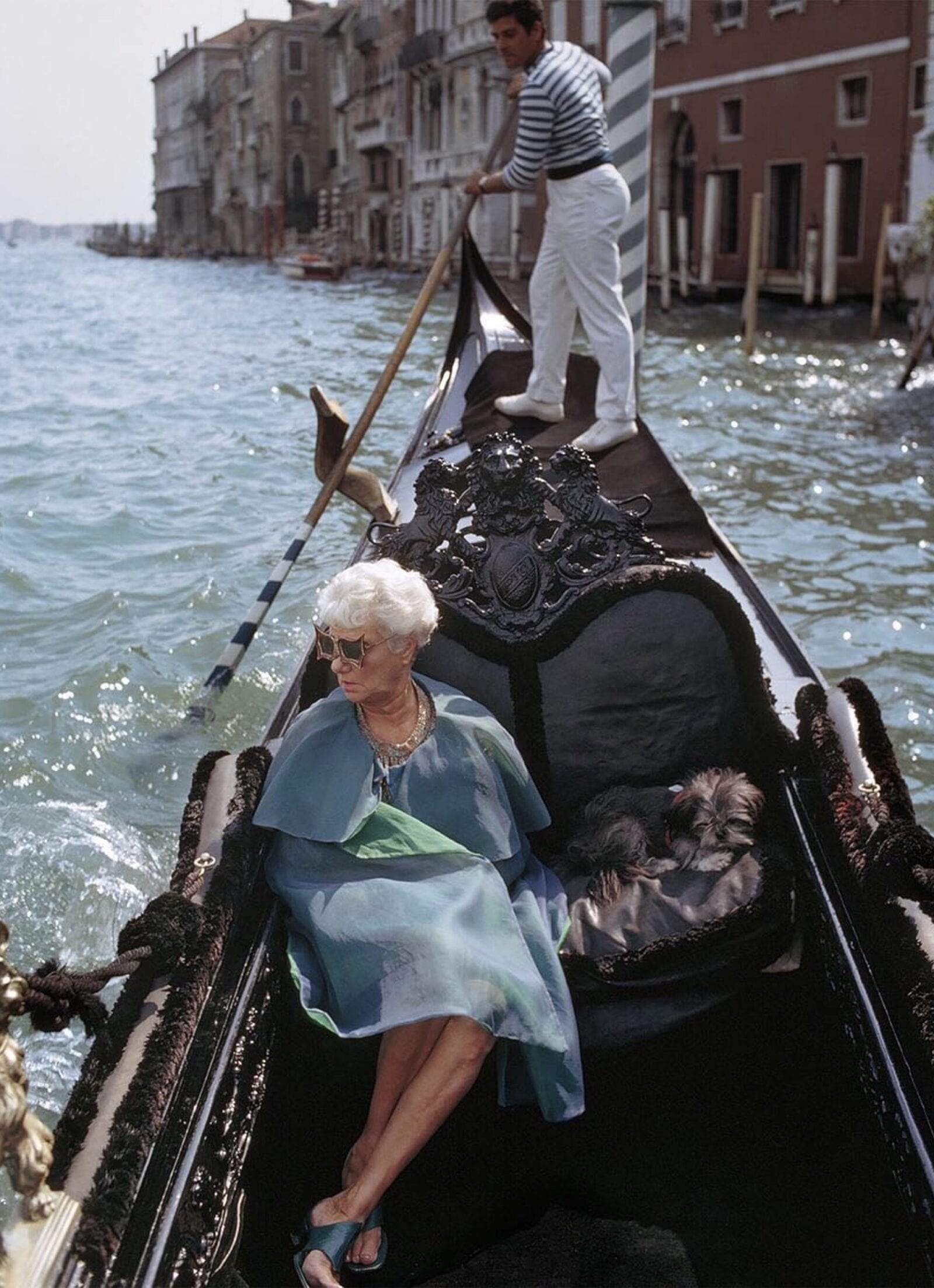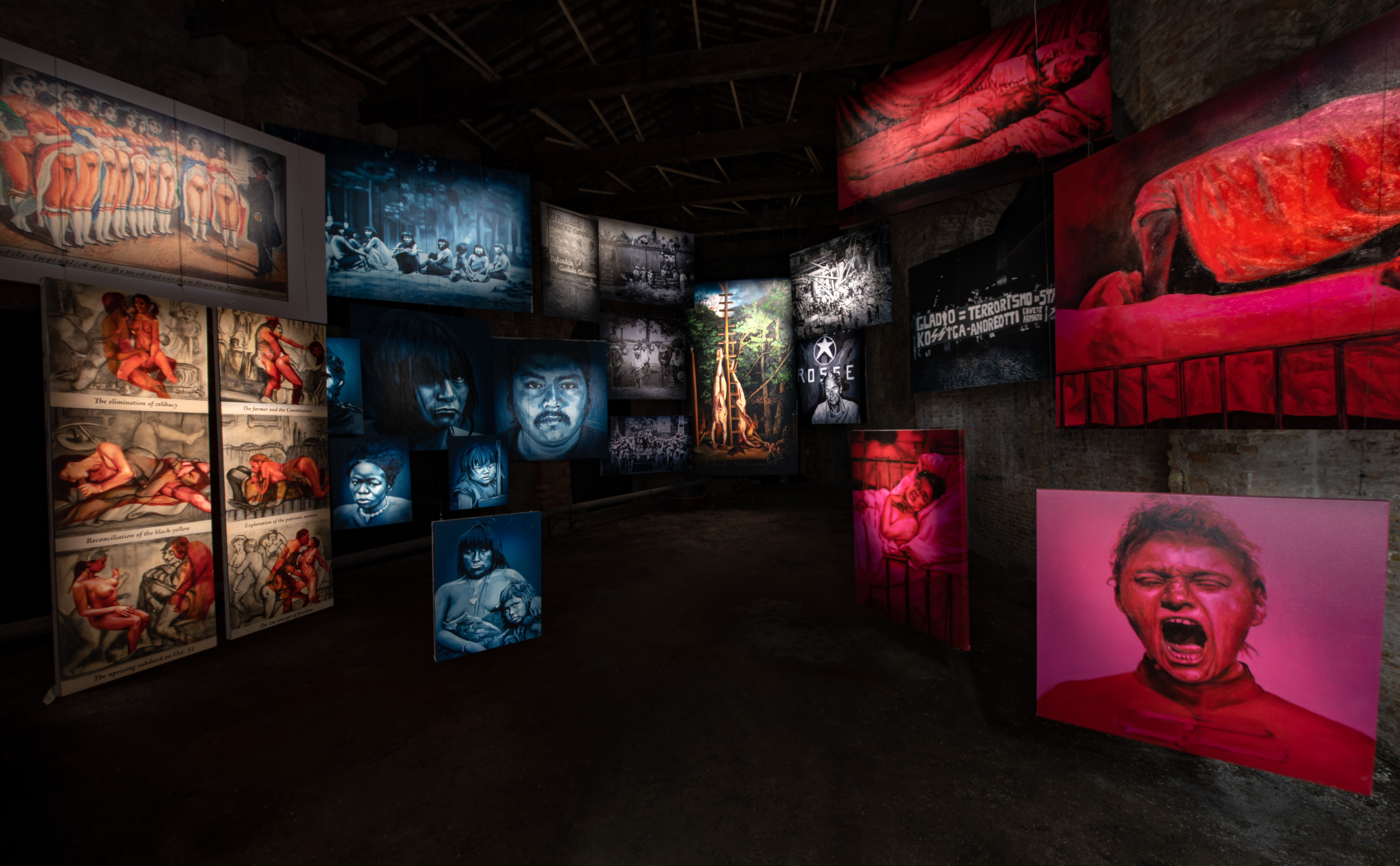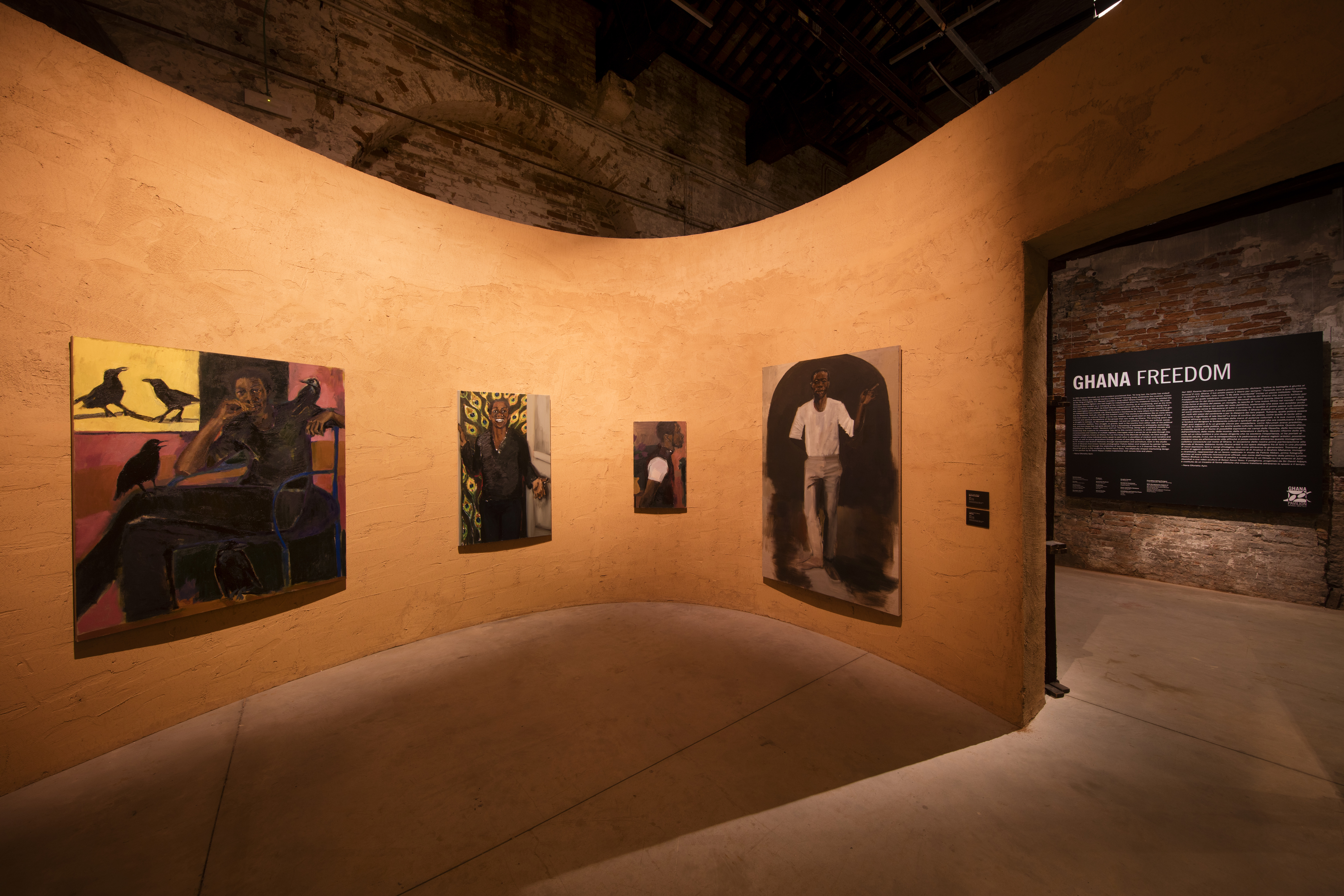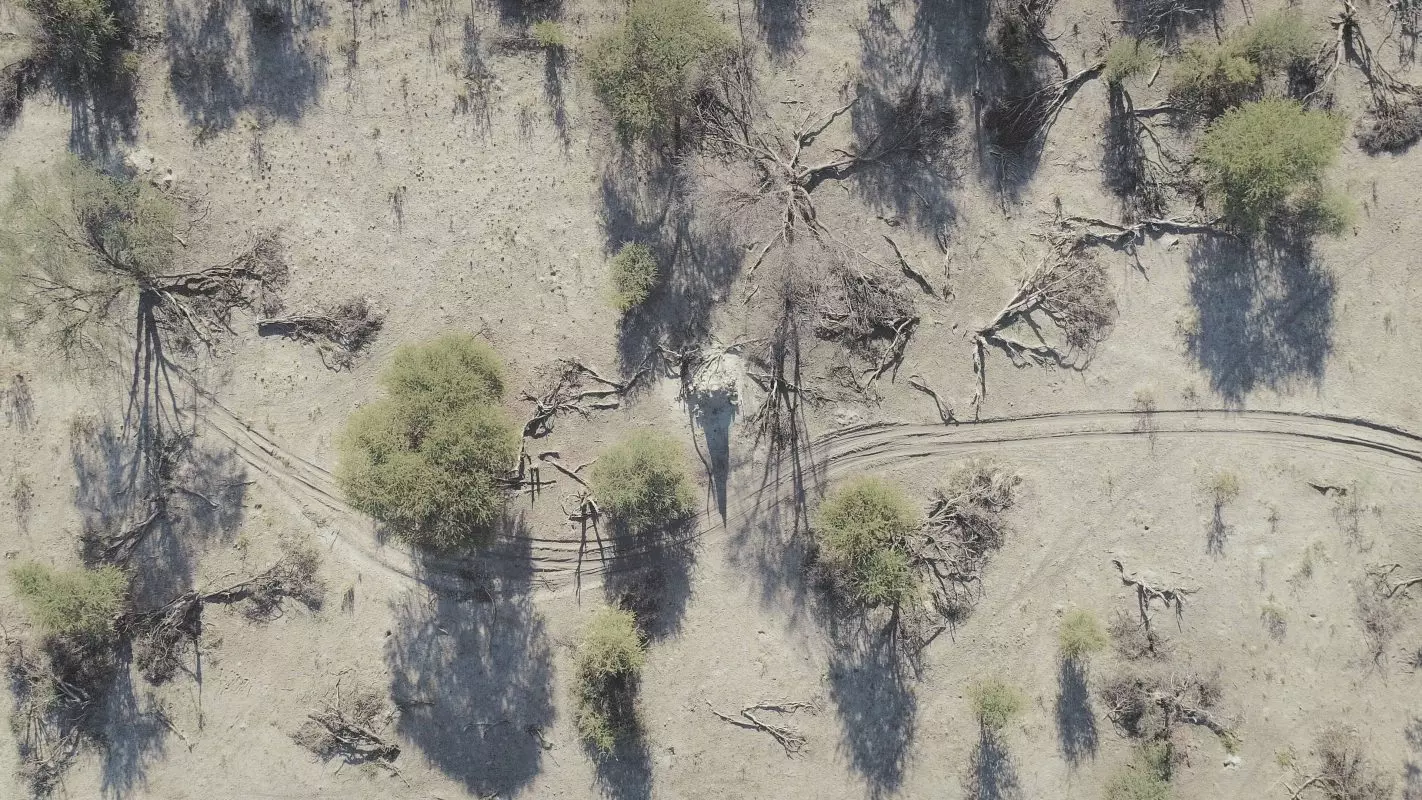Venice Biennale 2019: The Must-See Pavilions and Exhibitions by Women Artists, Beyond the Giardini

Women are triumphant at this year’s biennale: Lithuania won the sought-after Golden Lion award for best international pavilion, curated and created by an all-women dream-team we might add. Meanwhile London’s HEIST Gallery brought together 22 trailblazing women artists in She Persists, a celebration of women artists from around the globe. Now that gender parity has been reached in the art world’s most prestigious event, we can only hope that other international fairs and biennales follow suit.
Here are our favourite women artists exhibiting in the lagoon city, ordered geographically:
Lithuanian Pavilion: Sun & Sea (Marina)

Rugile Barzdziukaite, Vaiva Grainyte, Lina Lapelyte, Sun _ Sea (Marina), opera-performance, Biennale Arte 2019, Venice © Andrej Vasilenko
Welcome to the Anthropocene – it’s sunny and salty here, but the Earth groans.
Artists: Rugilė Barzdžiukaitė, Vaiva Grainytė, Lina Lapelytė,
Curator: Lucia Pietroiusti, Curator of General Ecology at the Serpentine Galleries, London
Near Arsenale
Tucked in the winding streets behind the Arsenale, this is the first pavilion that ART SHE SAYS visited and fortunately, because once word spread of Sun & Sea’s originality and hypnotising power, queues for this pavilion were extraordinary – even by Venice’s standards.
Entering the cavernous, disused structure on the waterfront, the viewer occupies an omnipotent position above a man-made beach where lounging tourists moan and sigh in seemingly blissful idyll. But a polyphonic opera is performed by the beach dwellers, who dressed in bikinis with various plastic items spread across their towels, lament the threat of rising sea levels, coral bleaching and marine pollution. Consumerism and tourism clash with their words of environmental urgency. At times, a heavy bass thumps beneath the siren-like song, an aural reminder of man’s destructive power upon the oceans. The blasé visual jars with the operatic lyrics; the beach dwellers appear relaxed and at ease, failing to act on the anxieties they are singing about.
When it comes to the environment, this disconnect between our words and actions is the pressure point that the Lithuanian Pavilion hits. We are imprisoned by our own inertia, while activists like Greta Thunberg are relentlessly trying to instigate systemic change. With a song about sun cream, Barzdžiukaitė gently reminds us of both our own fragility and dependence upon the planet. Sun & Sea’s Venetian microcosm highlights universal attitudes of shirking environmental responsibility.
Chile Pavilion: Altered Views by Voluspa Jarpa

Voluspa Jarpa, T he Subaltern Portrait Gallery , Altered Views, 2019. Pavilion of Chile, 58th Venice Biennial. Photo Felipe Lavin
Traditional knowledge is subverted and transcended, the Eurocentric hegemony highlighted and disposed of.
Artist: Voluspa Jarpa
Curator: Agustín Perez Rubio
Arsenale
Jarpa’s art packs a punch and its acerbic message certainly wins our vote for the most important of the Biennale. Jarpa speaks up for the oppressed: women, colonial subjects, indigenous groups, political revolutionaries and those outside the heterosexual norm. Decolonisation of the gaze is at the centre of her work, which is subdivided into The Hegemonic Museum, The Subaltern Portrait Gallery and the Emancipating Opera. The culmination of 15 years of extensive research, Jarpa sharply reappropriates several key moments in colonial history across the 17th and 20th centuries. For example, she locks the psychiatrist Jean-Martin Charcot inside a mental institution, a reversal of reality; several thousand ‘hysterical’ women were studied by Charcot in Paris’ notorious La Salpêtrière asylum. Then there’s the zigzagging mirrors which throw the slender scope of Eurocentric knowledge in our faces, while a wall of declassified CIA documents spotlights the undercover western armies who fought to prevent the burgeoning left-wing in post-war Europe. It’s powerful stuff and Jarpa never shies away from revealing the truth, no matter how hard hitting.
Spivak’s subalterns finally get their voices heard in the portrait gallery, where historically silenced figures confront us with their othered status, subverting the large format oil painting typically used to present monarchs and autocrats. The distinctive face of Camilo Catrillanca hangs at the front, the grandson of an important Mapuche leader who was tragically shot by Chilean police last year. And a video shot high in the Chilean Andes features the politically non-conforming arrieros (muleteers) and Chilean trans-singer Daniela Vega, both unconventional figures in the conservative Latin American country. Give yourself sufficient time to absorb Jarpa’s genius at this pavilion – you’ll emerge with a different view of certain histories to the one you entered with.
Ghana Pavilion: Ghana Freedom

Lynette Yiadom-Boakye. The Ghana Pavilion, curated by Nana Oforiatta Ayim and designed by David Adjaye, at the 58th Biennale di Venezia. Venice Biennale. Venice, Italy. Photograph by David Levene
Charismatic and evocative art that whisks you away to Ghana.
Female artists: Felicia Abban and Lynette Yiadom-Boakye
Curator: Nana Oforiatta Ayim
Arsenale
If there was a prize for best newcomer, Ghana would have snapped it up. Stepping foot in the pavilion, a series of interlocking loops designed by all-star architect Sir David Adjaye uses red earth brought from Ghana to Venice while Ibrahim Mahama’s smoked fish mesh recreates the scent of a Ghanaian market. ‘Ghana Freedom’ has a 50:50 balance of male to female artists, including Felicia Abban’s studio photographs and self-portraits from the 1960s to 1970s and Turner-prize nominated painter Lynette Yiadom-Boakye’s iconic paintings. Abban was Ghana’s first female professional photographer. Now 83, her black and white portraits sit opposite Yiadom-Boakye’s arresting portraits of fictional people. Tertiary colours are offset by brushstrokes of vibrant shades, as she considers representation within art and interrogates identity – a timeless, valuable question.
Saudi Arabia Pavilion: After Illusion

A view of the Saudi Arabian Pavilion at the Venice Biennale. © MiSK Art Institute.
Tactile details and a beautiful aesthetic comment upon contemporary Saudi life.
Artist: Zahrah Al-Ghamdi
Curator: Eiman Elgibreen
Arsenale
This is a mesmerising exhibition but one that could be easily overlooked sandwiched between the United Arab Emirates and Argentine Pavilions. Enter inside, where a low humming resonates between huge installations that curve across the room, dividing the space into what feels like an infinity loop. Over 52,000 little circular structures nestle on veil-like sheaths of fabric. They could be pomegranate shells denuded of their seeds, the dried husks of poppies or the fossilised remains of sea urchins, gently cupped on a rocky shelf. They are in fact, made of leather and cut, shredded, dried and hand-sewn by Zahrah Al-Ghamdi via a slow, exact process. She mediates upon the sense of uncertainty that permeates Saudi culture, which on one hand feeds the global hegemony via its vast oil reserves while on the other, tries to stay true to its centuries-old values. Al-Ghamdi’s space feels ephemeral and transcendent – a balm after the Biennale madness that magnifies a different emotion each time you enter.
Otobong Nkanga and Zanele Muholi in ‘May you live in interesting times’

Photographs by Zanele Muholi in the Arsenale section of the 58th Venice Biennale’s main show, “May You Live in Interesting Times.” Ralph Rugoff, the show’s curator has divided his exhibition into two parts—“Proposition A” in the Arsenale and “Proposition B” in the Giardini. Almost ever artist appears in both, usually with a different kind of work.
Muholi’s figurative activism meets Nkanga’s sleek, winding work.
Arsenale
Ralph Rugoff’s central exhibition was inspired by the titular Chinese Proverb (as it turns out, no one from China ever uttered the words) and featured two shows: one, at the Giardini and the other inside the Arsenale. Rugoff’s idea was to create two simultaneous exhibitions exhibiting the same artists yet each with a completely different feel. Opinion was divided as to the effectiveness of Rugoff’s curatorial choice, whose hefty premise was based upon ideas of philosophical heavyweights Leonardo da Vinci and Karl Marx. It can be a challenge to make sense of this giant exhibition but head to the Arsenale, where the works of South African Zanele Muholi and Nigerian-born Otobong Nkanga face each other – two powerful female artists in dialogue it seems.
Muholi’s mighty self-portraits are unmissable and works from her series ‘Hail the dark Lioness’ preside over the Arsenale. Both personal and intensely political, each of Muholi’s Zulu-named works emanates a raw power that challenges notions of victimhood and subjugation of the black woman. Opposite, Otobong Nkanga’s 26 metre-long glass and marble sculpture ‘Veins Aligned’ snakes along the floor. Built using marble from quarries in the Italian Tyrol, the elongated sculpture appears as a spine, embodying Nkanga’s views of the landscape as a body. Nkanga won a Special Mention at the Biennale for her ongoing exploration into the politics of land, body and time.
Pakistan Pavilion: Manora Field Notes by Naiza Khan

Pavilion of Pakistan (Installation view of Sticky Rice and Other Stories, Naiza Khan, 2019). Credit Riccardo Tosetto Photography
Remembering an island whose identity has been eroded over time.
Artist: Naiza Khan
Curator: Zahra Khan
Near Arsenale
Pakistan’s début at the Venice Biennale is led by two women, a decision which speaks volumes. Naiza Khan’s work is rooted firmly in a sense of place, namely Manora Island – a slender spit of land that lies south of Karachi, Pakistan. Once home to a British weather observatory, Manora evolved into a popular beach destination for Karachi’s working-class. But now, as Khan shows through a series of uncluttered films – the best of which is viewed through a set of rusting binoculars – the island has been left behind, its inhabitants and its history largely forgotten about. Acting as historian, geographer and social chronicler, Khan explores the island’s alternate geographies in a body of work that is both exact and poetic. Filled with bronze casts of cities and objet trouvés from local markets, the first room feels a little blingy and doesn’t quite match up to the rest of the exhibition, but persevere for the island’s narrative is woven carefully throughout each of the three spaces. Peering through the fixed binoculars at Manora’s stained walls and dusty streets, it’s easy to skate into your own childhood nostalgia of overdone beach fronts and tourist viewing platforms, sewn into your memory along with the smell of suncream and seagull cries.
Scotland Pavilion: Charlotte Prodger, SaF05

Big cat diary, an installation view of SaF05. Photograph: Cristiano Corte/courtesy of the artist and Koppe Astner and Hollybush Gardens galleries
A dive into the artist’s mind, where big cats, bagpipes and the queer body intermingle.
Artist: Charlotte Prodger
Curator: Linsey Young
Near Arsenale
We are travelling along a dusty road in what feels like a safari truck, the synaesthesia of the shot emphasised by footage shot on the artist’s phone. Suddenly we swerve off the dead-straight road, taking an unseen bend that feels unpredictable and adrenaline-inducing. It’s a metaphor for the themes that Prodger deals with in her work, melding her queer identity into notions of wilderness, land degradation and subjectivity. Filmed in Botswana, the Scottish Highlands, America and the Ionian Islands, Prodger’s work feeds both our sense of wanderlust and curiosity of others’ lives. Prodger’s film opens with a natural anomaly – a maned lioness, one of several known to conservationists that roam in the Okavango Delta.

The Turner prize-winning artist’s work is both subtle and expletive: bagpipes play over stark desert shots, Prodger examines her teenage experience in Aberdeenshire as she explores the wider implications of a female lion that displays male characteristics. We view her complex narrative from multiple perspectives, places and positions; Prodger quite rightly refuses to pigeon-hole her queer experience. Between footage that is aerial (drone), hand-held and trap-camera, we are privy to Prodger’s intimate thoughts, then demoted to side-lined listener of crackling radio dialogue that plays across Botswana’s silent landscape. Once you’re on-board with the artist-centric nature of her work, sink into Prodger’s layered and hauntingly beautiful world.
Brazil Pavilion: Swinguerra

Swinguerra still, by Bárbara Wagner & Benjamin de Burca
Raw, untethered dance that speaks of the pressures faced by Brazilian teens.
Curator: Gabriel Pérez-Barreiro.
Artists: Bárbara Wagner and Benjamin de Burca
Giardini
Wagner and de Burca’s portrayal of Brazilian contemporary culture is explosive and subversive. A film shows young Brazilians dancing in a sports hall. Its name ‘Swinguerra’ plays on the Brazilian dance form ‘swingueira’, combining it with the Brazilian word for war: ‘guerra.’ Typically, Swingueira’s explicit lyrics are gender-violent and firmly heterosexual yet Wagner and de Burca remove this gender divide through their inclusion of girls, boys, non-binary individuals and same-sex relationships. The film presents in black and white, the difficulty faced by young people growing up in a socially and politically troubled Brazil, yet the dance is affirming and empowering. Low-angled shots of the dancers place them in authoritative positions while black bodies take centre stage. It’s a powerful and surprisingly emotional film that at times, can feel like a music video.
She Persists, an all-female exhibition at the Palazzo Benzon

‘She Persists’ by Heist Gallery
Narratives of empowerment, resilience and rebellion amidst 18th century splendour.
Curators: HEIST Gallery founder Mashael Al Rushaid and Sona Datta
On the Grand Canal, until 6 June.
Enter She Persists and a quote from Guerrilla Girls greets you on the stairs (their posters also feature in the exhibition). Upstairs, the tangerine-tinged desert-scape of Judy Chicago’s Women in Smoke resides gloriously, the portal to 22 works by both established and emerging women artists who have moulded art history to include the complexity of female experience in countries ranging from Britain, to Pakistan, Japan and Iran. Lahore-based Aisha Abid Hussain’s tongue-in-cheek photography incorporates the contemporary notion of sologamy (marriage to oneself) into the traditional image of a Pakistani wedding.

Paradise Bath by Hamra Abbas, ‘She Persists’ by Heist Gallery
Hamra Abbas’ Paradise Bath, a series of photographs in which Abbas gives a nude white woman the traditional hammam, must be destroyed if unsold. Pakistan’s strict censors do not accept woman to woman relations or displays of ‘indecency.’ This poignancy is a sharp reminder of the context in which some of these artists are creating. And at the opening event, performance artist Mithu Sen exploded into being like a supra-lingual tornado. Somewhere between an Indian Deva and whip-like politician, the red-clad Sen takes a mallet to traditional ideas of gender, the body and sexuality. Don’t miss her body of work (Un)Mansplaining, that confronts femicide and violence against women.



